Results
-
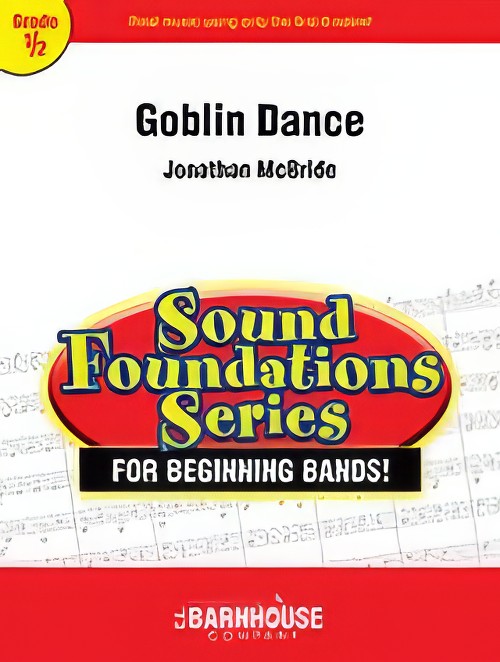 £50.00
£50.00Goblin Dance (Concert Band - Score and Parts) - McBride, Jonathan
Goblin Dance for beginning band uses only the first six notes learned in band instruction, and is an ideal bridge from method book exercises to concert music! Unison themes are introduced so each member of the band gets to play the melody, before dividing into melody and harmony provided by the low brass and woodwinds. A second theme is introduced in unison, followed by the Goblin Dance finale when all three parts: melody, harmony, and second theme join together for an exciting and mature-sounding finish. You and your bands will enjoy working on this catchy and rhythmic beginning band piece that your audiences will love. Spooky fun! Duration: 1.30
Estimated dispatch 7-14 working days
-
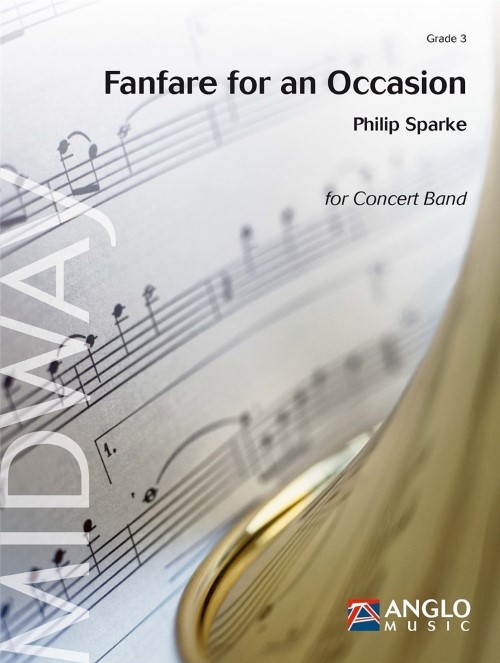 £74.99
£74.99Fanfare for an Occasion (Concert Band - Score and Parts) - Sparke, Philip
Fanfare for an Occasion was written to celebrate the 20th anniversary of the founding of Anglo Music Press, the publishing company dedicated to the works of British composer, Philip Sparke. It is a bright and festive work in which the main theme starts on the tenor instruments of the band before appearing as canonical imitation by all sections in turn. A short, repeated bridge passage leads to a second theme on the saxes that is taken up by the full band and leads back to a return of the main theme and a repeat of the second subject, which brings the fanfare to a brilliant close. Duration: 2.00
Estimated dispatch 7-14 working days
-
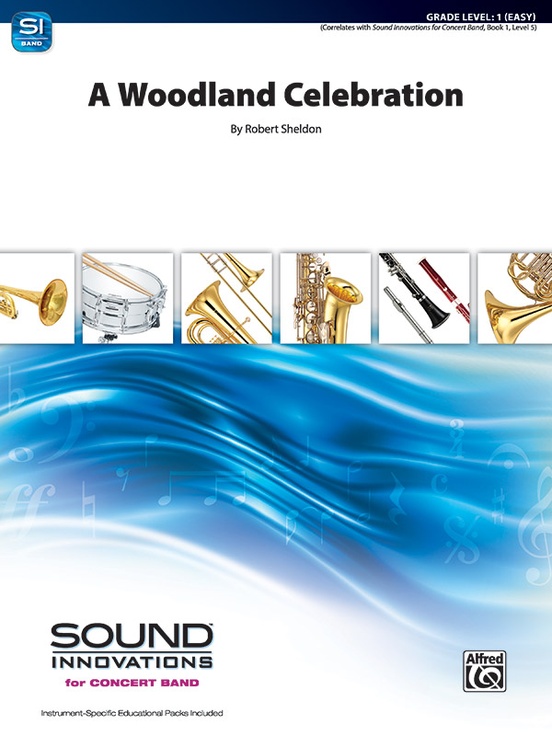 £52.95
£52.95A Woodland Celebration (Concert Band - Score and Parts) - Sheldon, Robert
Perfect for opening or closing a concert for first-year band students, A Woodland Celebration by Robert Sheldon lends a light rhythmic style to a tuneful melody. As soon as young students can play a concert B-flat scale and learn the note concert A-flat, this piece is easily playable. Second clarinet does not go over the break, and second trumpet and horn have limited ranges as well. Duration: 1.45
Estimated dispatch 7-14 working days
-
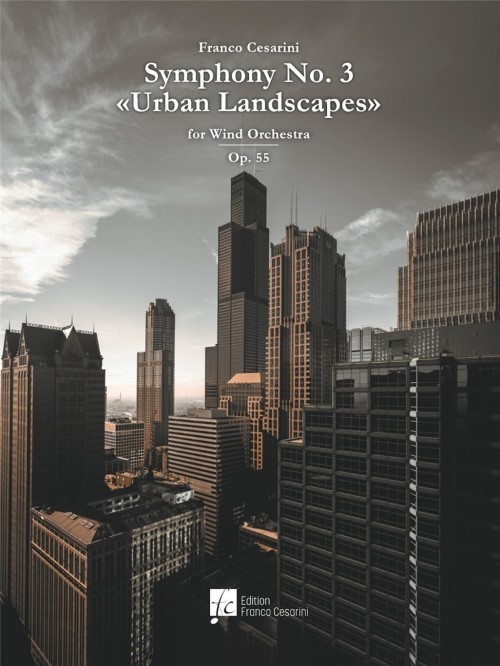 £407.00
£407.00Symphony No.3 (Urban Landscapes) (Concert Band - Score and Parts) - Cesarini, Franco
Fascinated by the beauty of Chicago, Franco Cesarini has translated his emotions into music: this is how Symphony No. 3 "Urban Landscapes" Op. 55, was born, a musical portrait of this metropolis overlooking Lake Michigan. The composition is divided into three movements: The Wrigley Building from Dawn to Noon, Blue Silhouette and Cloud Gates, which by sharing the same thematic material arranged in cyclical form, strengthen the overall cohesion of the piece. The first movement, preceded by a short slow introduction in which the main theme is presented in an almost dreamlike form, metaphorically represents the city at dawn. The sudden change of time symbolizes the start of activities with all its noises and sounds: you can hear the bell that announces the closing of the subway doors, the sound of cars speeding by, the siren of a patrol car. If the first movement represents the day, the second introduces a nocturnal environment: a melancholic melody played by the English horn anticipates a more animated tempo depicting melodies coming from jazz clubs. Powerful fanfares that take up the second theme of the first movement introduce the third movement. In this finale, the role of the two themes is reversed compared to the first movement and one takes the place of the other in a kind of games of mirrors. Symphony No. 3 "Urban Landscapes" Op. 55: a sumptuous musical portrait of the "Windy City". Duration: 27.00
Estimated dispatch 7-14 working days
-
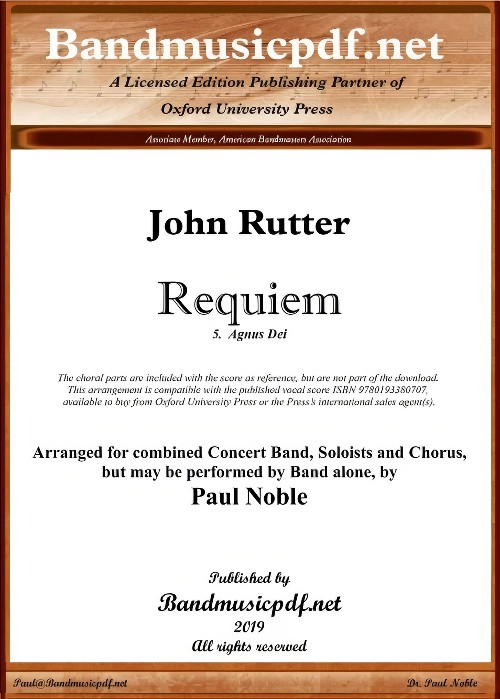 £110.00
£110.00Agnus Dei (from Requiem) (Concert Band with Optional Choir - Score and Parts) - Rutter, John - Noble, Paul
John Rutter's Requiem is a musical setting of parts of the Latin Requiem with added psalms and biblical verses in English, completed in 1985. This arrangement is scored for soprano, mixed choir and Concert/Wind Band. It may be performed by band alone. Five of its seven movements are based on text from the Latin Requiem Mass, while the second movement is a setting of Out of the deep (Psalm 130) and the sixth movement is an anthem The Lord is my Shepherd (Psalm 23) which Rutter had earlier written. The cello solo of the second movement is maintained, but also scored as a bassoon solo. The first movement combines the Introit and Kyrie, the third is Pie Jesu, with soprano solo. The central movement is a lively Sanctus, followed by Agnus Dei and finally Lux aeterna. In the Agnus Dei and Lux aeterna, Rutter combines the liturgical Latin text with English biblical verses. The arranger has added the tolling of the bell at the end, which can be as few or as many as may be appropriate for the occasion.
Estimated dispatch 7-14 working days
-
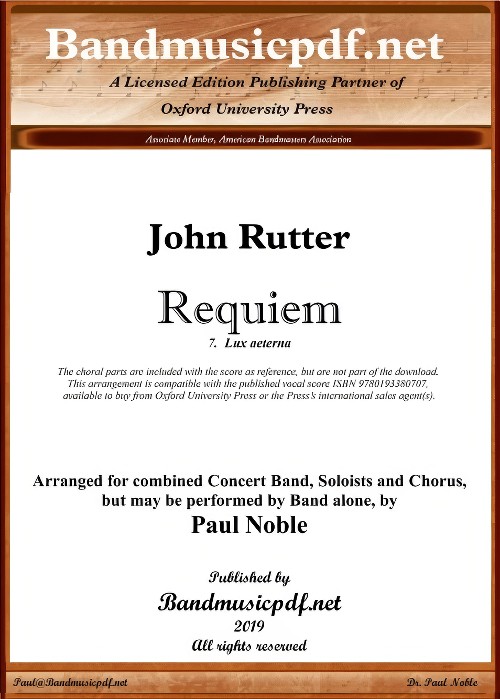 £110.00
£110.00Lux Aeterna (from Requiem) (Concert Band with Optional Choir - Score and Parts) - Rutter, John - Noble, Paul
John Rutter's Requiem is a musical setting of parts of the Latin Requiem with added psalms and biblical verses in English, completed in 1985. This arrangement is scored for soprano, mixed choir and Concert/Wind Band. It may be performed by band alone. Five of its seven movements are based on text from the Latin Requiem Mass, while the second movement is a setting of Out of the deep (Psalm 130) and the sixth movement is an anthem The Lord is my Shepherd (Psalm 23) which Rutter had earlier written. The cello solo of the second movement is maintained, but also scored as a bassoon solo. The first movement combines the Introit and Kyrie, the third is Pie Jesu, with soprano solo. The central movement is a lively Sanctus, followed by Agnus Dei and finally Lux aeterna. In the Agnus Dei and Lux aeterna, Rutter combines the liturgical Latin text with English biblical verses. The arranger has added the tolling of the bell at the end, which can be as few or as many as may be appropriate for the occasion.
Estimated dispatch 7-14 working days
-
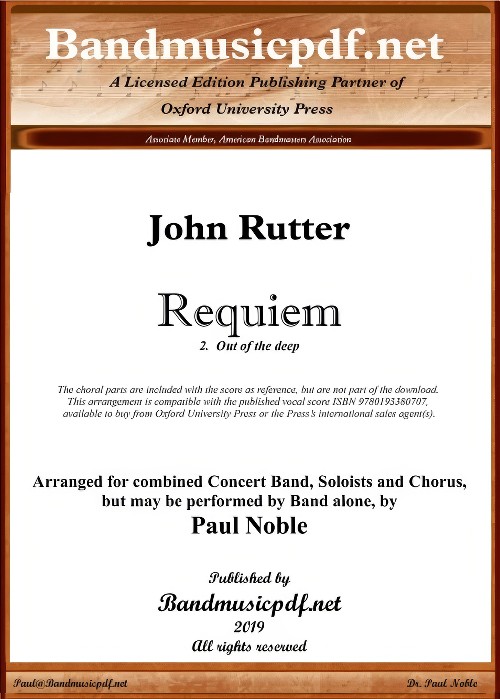 £110.00
£110.00Out of the Deep (from Requiem) (Concert Band with Optional Choir - Score and Parts) - Rutter, John - Noble, Paul
John Rutter's Requiem is a musical setting of parts of the Latin Requiem with added psalms and biblical verses in English, completed in 1985. This arrangement is scored for soprano, mixed choir and Concert/Wind Band. It may be performed by band alone. Five of its seven movements are based on text from the Latin Requiem Mass, while the second movement is a setting of Out of the deep (Psalm 130) and the sixth movement is an anthem The Lord is my Shepherd (Psalm 23) which Rutter had earlier written. The cello solo of the second movement is maintained, but also scored as a bassoon solo. The first movement combines the Introit and Kyrie, the third is Pie Jesu, with soprano solo. The central movement is a lively Sanctus, followed by Agnus Dei and finally Lux aeterna. In the Agnus Dei and Lux aeterna, Rutter combines the liturgical Latin text with English biblical verses. The arranger has added the tolling of the bell at the end, which can be as few or as many as may be appropriate for the occasion.
Estimated dispatch 7-14 working days
-
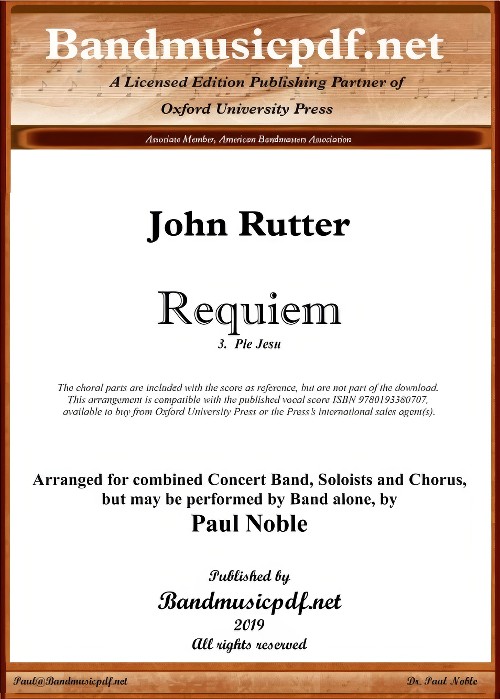 £110.00
£110.00Pie Jesu (from Requiem) (Concert Band with Optional Choir - Score and Parts) - Rutter, John - Noble, Paul
John Rutter's Requiem is a musical setting of parts of the Latin Requiem with added psalms and biblical verses in English, completed in 1985. This arrangement is scored for soprano, mixed choir and Concert/Wind Band. It may be performed by band alone. Five of its seven movements are based on text from the Latin Requiem Mass, while the second movement is a setting of Out of the deep (Psalm 130) and the sixth movement is an anthem The Lord is my Shepherd (Psalm 23) which Rutter had earlier written. The cello solo of the second movement is maintained, but also scored as a bassoon solo. The first movement combines the Introit and Kyrie, the third is Pie Jesu, with soprano solo. The central movement is a lively Sanctus, followed by Agnus Dei and finally Lux aeterna. In the Agnus Dei and Lux aeterna, Rutter combines the liturgical Latin text with English biblical verses. The arranger has added the tolling of the bell at the end, which can be as few or as many as may be appropriate for the occasion.
Estimated dispatch 7-14 working days
-
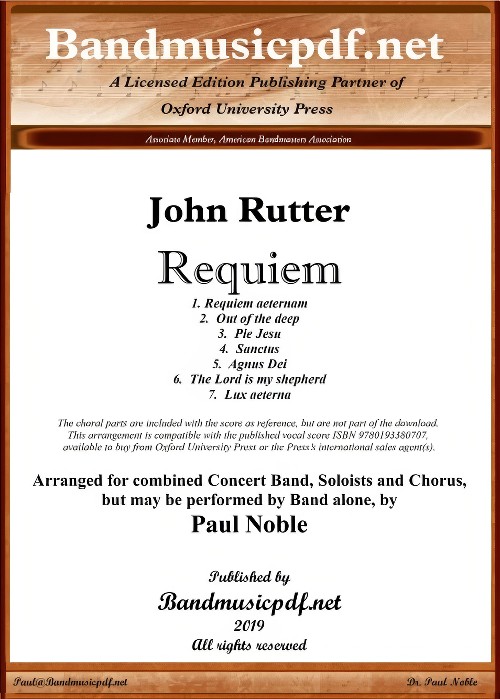 £625.00
£625.00Requiem (Concert Band with Optional Choir - Score and Parts) - Rutter, John - Noble, Paul
John Rutter's Requiem is a musical setting of parts of the Latin Requiem with added psalms and biblical verses in English, completed in 1985. This arrangement is scored for soprano, mixed choir and Concert/Wind Band. It may be performed by band alone. Five of its seven movements are based on text from the Latin Requiem Mass, while the second movement is a setting of Out of the deep (Psalm 130) and the sixth movement is an anthem The Lord is my Shepherd (Psalm 23) which Rutter had earlier written. The cello solo of the second movement is maintained, but also scored as a bassoon solo. The first movement combines the Introit and Kyrie, the third is Pie Jesu, with soprano solo. The central movement is a lively Sanctus, followed by Agnus Dei and finally Lux aeterna. In the Agnus Dei and Lux aeterna, Rutter combines the liturgical Latin text with English biblical verses. The arranger has added the tolling of the bell at the end, which can be as few or as many as may be appropriate for the occasion.
Estimated dispatch 7-14 working days
-
 £110.00
£110.00Requiem aeternam (from Requiem) (Concert Band with Optional Choir - Score and Parts) - Rutter, John - Noble, Paul
John Rutter's Requiem is a musical setting of parts of the Latin Requiem with added psalms and biblical verses in English, completed in 1985. This arrangement is scored for soprano, mixed choir and Concert/Wind Band. It may be performed by band alone. Five of its seven movements are based on text from the Latin Requiem Mass, while the second movement is a setting of Out of the deep (Psalm 130) and the sixth movement is an anthem The Lord is my Shepherd (Psalm 23) which Rutter had earlier written. The cello solo of the second movement is maintained, but also scored as a bassoon solo. The first movement combines the Introit and Kyrie, the third is Pie Jesu, with soprano solo. The central movement is a lively Sanctus, followed by Agnus Dei and finally Lux aeterna. In the Agnus Dei and Lux aeterna, Rutter combines the liturgical Latin text with English biblical verses. The arranger has added the tolling of the bell at the end, which can be as few or as many as may be appropriate for the occasion.
Estimated dispatch 7-14 working days
